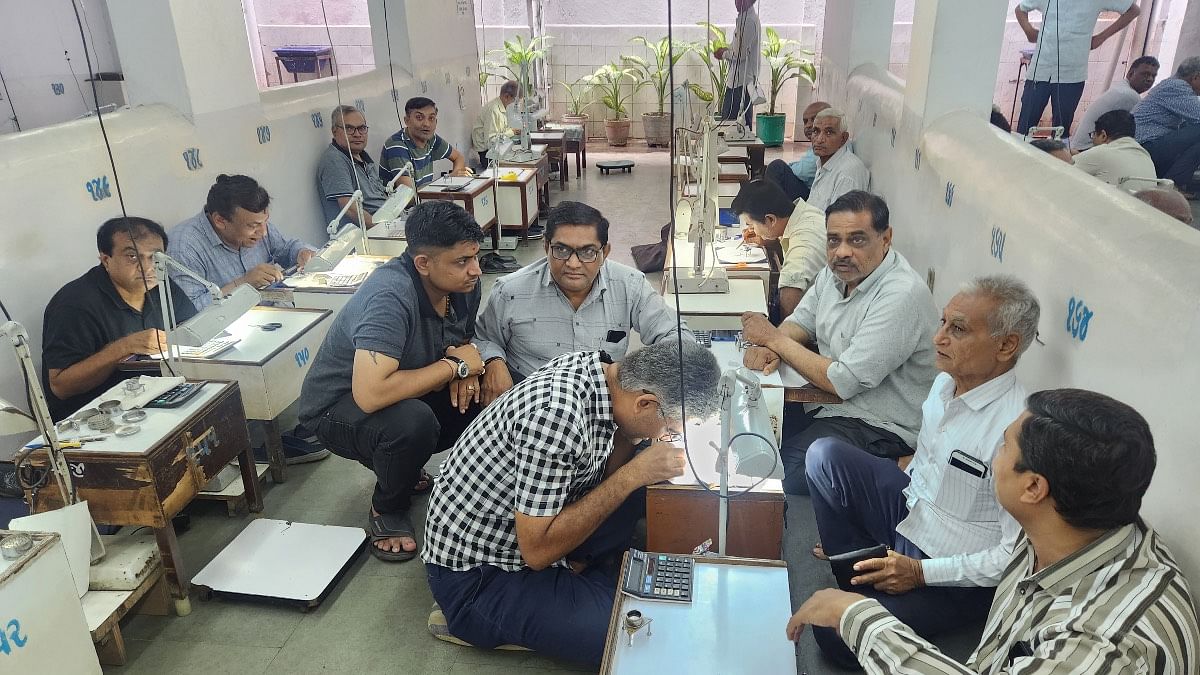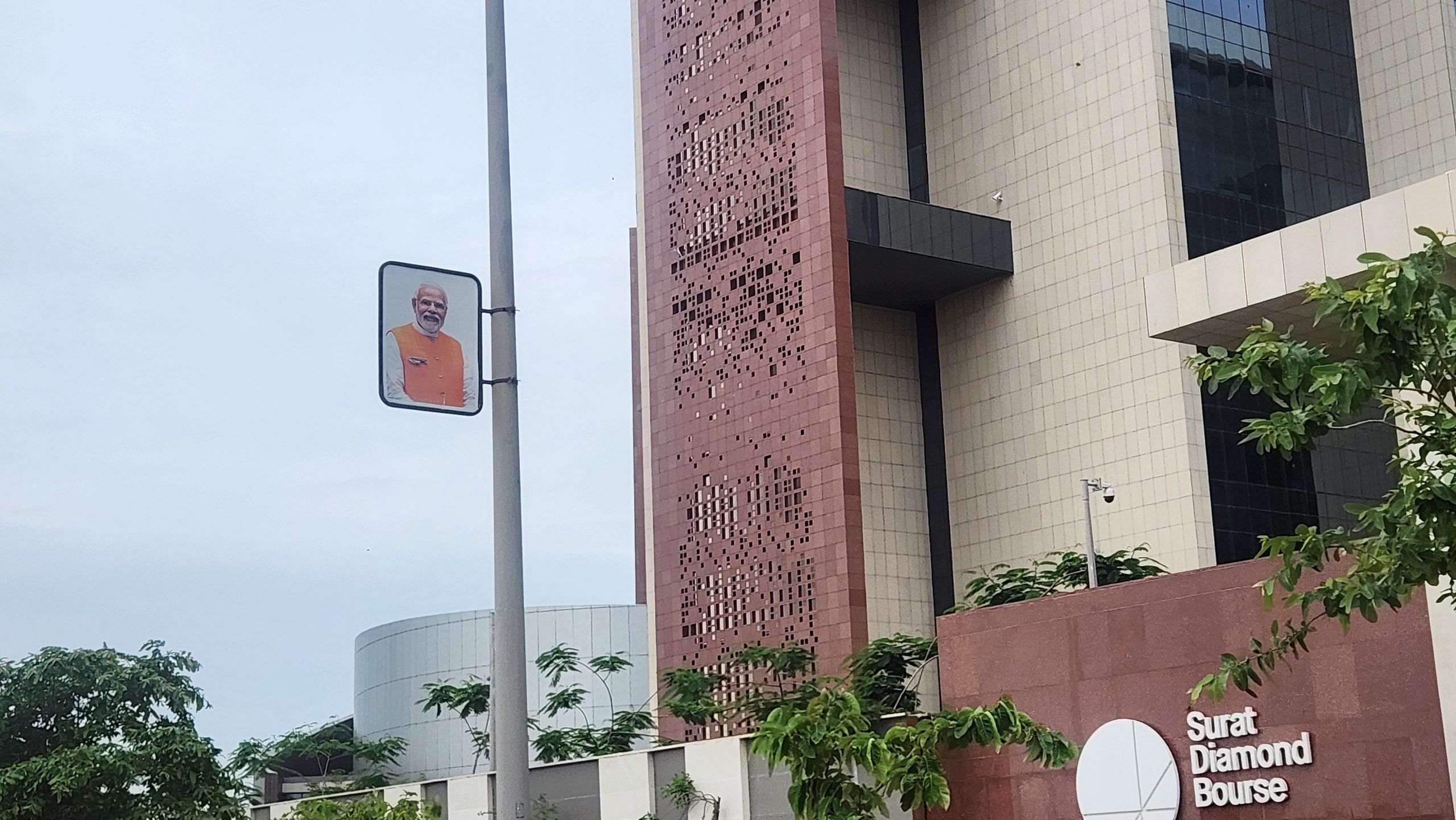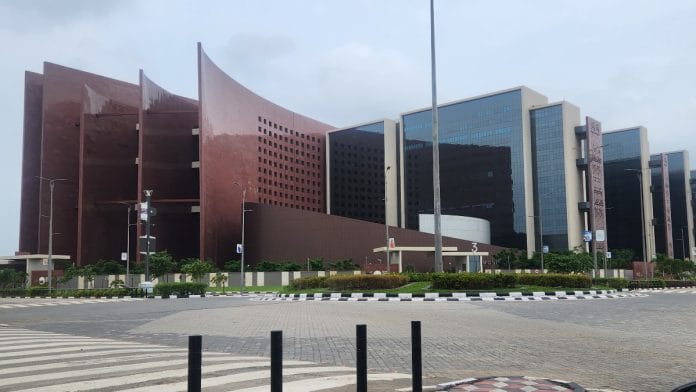Surat: It was sometime after 11 am on a Monday, but, over 10 km from the centre of Surat, Gujarat, in the Diamond City, the sprawling complex of the newly built Surat Diamond Bourse (SDB) — its streets lined with posters of Prime Minister Narendra Modi advertising the government’s vision of Amrit Kaal and an under-construction metro just opposite its towering buildings — was fairly empty.
The SDB, near Khajod village, was inaugurated by Prime Minister Narendra Modi in December 2023 with much fanfare. “The bourse will be a ‘one-stop solution’ for everyone in the diamond industry, from workers to traders, and will employ 1.5 lakh people. Today, in the form of the Surat diamond bourse, a large centre for international trade is ready,” the PM said at the ceremony. But, nearly seven months on, the grand plans have barely taken shape — hardly any offices have opened at the massive complex and many of those who had left Mumbai for Surat have gone back.
The SDB complex is spread across 64 lakh sq ft has nine towers, with 15 floors each, and can hold up to 4,000 offices. While officially the SDB has said that about 250 offices are operational, people familiar with the development told ThePrint that only about 10 are actually functional offices. The rest are still in the middle of construction.
“Only about 250 offices have started now. We expect by Diwali that more merchants, especially from Surat and neighbouring areas, will start their offices in the Diamond Bourse. Slowly, many from Mumbai will also come here,” Ashesh Doshi, vice-president of the SDB, told ThePrint.
But a merchant, on condition of anonymity, said, “We hope that these offices will soon be functional as well, since the furniture and other interiors are getting made. But it is true that the project has not kicked off as expected. The response was not there as buyers won’t come to SDB. Maybe by Diwali, we can see 1,000 offices opening.”
Inadequate infrastructure, slowdown in global market, and delays in building the bullet train are some of the reasons not many have shifted to SDB, merchants told ThePrint. It has also become a political issue. Since the Shinde-Fadnavis government came to power in Maharashtra in 2022, the opposition Maha Vikas Aghadi (MVA) has accused the government of taking industries from to Gujarat to Maharashtra. Regional political leaders, such as the Shiv Sena (UBT)’s Aaditya Thackeray, have made the diamond bourse one of their election talking points, accusing Modi of transferring Mumbai’s markets and opportunities to Gujarat.
The first setback: Lakhani leaves bourse
By November 2023, Vallabh Lakhani, owner of Kiran Gems and the largest diamond player in the industry, had purchased a nearly 1 lakh sq ft area in the SDB. He had shifted his trading office and staff from Mumbai to SDB. To encourage others to make the move, he even built accommodation for his staff in the SDB area. However, according to people familiar with the matter, his business soon saw a slump and, by January, he had wound up his business in Surat and re-opened in Mumbai.
“He had shifted here, winding up his business in Mumbai. He was here for two months. But the expectation that at least 50-100 traders would follow him did not pan out,” said Dinesh Navadiya, former president of SDB.
ThePrint has reached Kiran Gems for comment over email.
Also read: Mumbai to lose some of its sheen as diamond merchants, dazzled by new bourse, plan move to Surat
Infrastructural inadequacies
Part of the issue of why buyers did not come to Surat, resulting in Lakhani’s business losses, stems from the lack of infrastructure, people familiar with the development said. Since Khajod is on the outskirts of Surat, there is no direct transport to the complex. There is the metro construction opposite its front gates but, by the looks of the half-constructed pillars, it will take a while to complete. (The government expects the Surat metro to be completed by December 2027.)
Employees have the option to use their personal vehicles or to take app-based cabs. Another option is a bus service that Surat Diamond Bourse authorities started from Mahidharpura, Varachha and Chowksi Chowk — the main areas where traders and brokers buy and sell polished diamonds to merchants — to the SDB. These buses run every hour and are free of charge. The journey takes between half an hour and forty minutes, depending on where they board.
“The infrastructure needs to be in place. If the business is to flourish, we need buyers to come, and for that, there have to be good transport and export facilities. All this needs to be first taken care of, and then SDB will also grow,” said Rashmikant Dhanak, owner of Pramukh Jewellers in Surat. He also said that one of the major issues in the beginning was that the management of the diamond bourse concentrated on getting the big players to the bourse, often neglecting the middle traders.
“The middle traders are also big in the chain and they should have been accommodated as well,” he said.

In April, the SDB approached traders in the Mahidharpura Hira Bazar, located on a narrow congested street in old Surat, to shift their businesses to the new site as soon as possible. Here, in the bylanes, thousands of traders buy and sell polished diamonds. One of them is Madhubhai Khari, who was performing a purity check the day ThePrint spoke to him.
Wearing a lens, he would pick up a diamond with a tweezer and put it on a slide, checking, one by one, the purity of at least 20 round diamonds, which can be five times smaller than a Re 1 coin. “This [the purity check] will determine how many carats this diamond is and help determine its worth. Our job is extremely important. Many buyers come to me, from Surat and Mumbai. Without us, SDB won’t succeed,” he said.
His partner, Giridharibhai Khari, however, expressed hope that they would shift their business if the SDB facilities and the international market improve.
The traditional table-and-mat service will also be provided to attract the traders to SDB, they told ThePrint.
But a few shops ahead, another trader, who did not want to be named, said, “Let the merchants go there first. Buyers are not going there because the infrastructure is not in place. The airport is also not fully functional yet. I won’t go just yet.”
Another roadblock: customs clearance
The trader was referring to the airport’s customs clearance house, which hasn’t begun operations yet as a few permissions are still pending. The Surat airport was classified as an international airport seven months ago when the PM inaugurated the SDB. According to reports, the airport handles only 35 flights a day, as compared to an average of 1,000 in Mumbai, and is still not a 24/7 operational airport. According to its website, it operates only a few international flights to Dubai, Sharjah, and Bangkok.
“So what is the point? You still have to go to Mumbai to export your product. It is one of the deterrents for people to shift from Mumbai,” said another diamantaire based in Surat. The customs clearance permission should come in a months’ time, according to people from the industry.
The ambitious Mumbai-Ahmedabad bullet train isn’t yet operational either. Construction work, however, is in full swing: the excavation work for an intermediate tunnel, which was started on 6 December 2023, has been completed for the entire length of 394 metrees. An additional 394-metre intermediate tunnel has been made at Ghansoli in Mumbai. This new intermediate tunnel will help speed up the 21-km-long main tunnelling work between BKC and Shilphata, abutting the Thane creek.
“Once the bullet train starts, it will be easier for the merchants or even buyers to commute. That way, even if there is less air connectivity, at least the bullet train will be there,” said Dhanak. The bullet trains are expected to start running by 2028.
Slowdown in the global market
But the biggest issue, according to most industry insiders, is the global slowdown in the diamond market. For the year 2023-24, the diamond business was estimated at $29.73 billion, falling from $37.74 billion the previous year and $39.57 billion the year before last.
“In the last three years, the main problem has been the international market, especially in America and China — our biggest consumers. And so, the growth that we expect at SDB is not fast,” said Navadiya, the former SDB president.
“We are going to small traders, holding meetings, requesting them to come to SDB, and telling them how, at the Surat Diamond Bourse, the offices’ value would go up. But the main issue is of the market. Even in Mumbai, merchants are facing issues, so here (in Surat), it is not a surprise,” he added.
Now warring diamond hubs
Mumbai and Surat are both diamond hubs, but have traditionally performed separate functions in the industry. Surat has been the manufacturing hub, and Mumbai the export base. There are over 4,500 small, medium and big diamond factories in Surat that give employment to over six lakh people.
Rough diamonds from the mines of Africa, Russia, and Belgium make their way to Surat, where they are cut and polished. According to the Gems and Jewellery Export Promotion Council (GJEPC), Surat cuts and polishes 90 percent of the world’s diamonds, and has been a leader on this front since the 1960s. Once polished, they are sent to Mumbai.
Surat is dominated by the Patidar community. A majority of the committee members in the old Surat Diamond Bourse committee were also Patidars.
In the 1970s, when this two-city system was established, diamond merchants had originally set up offices in Mumbai’s Dagina Bazar. Later, they moved to the city’s Opera House area, and, in 2010, when the Bandra-Kurla Complex (BKC) was opened, the Bharat Diamond Bourse (BDB) was shifted there. Merchants were reluctant to move to BKC, and many still have shops in Zaveri Bazaar, but, since the move was within city limits, slowly many moved their offices to BKC.
The BDB Complex is spread over 20 acres (0.87 million sq ft). There are in all nine towers, which house 2,500 offices of various sizes and almost 4,000 members associated with BDB, according to its website. It handles about 98 percent of India’s diamond exports.
BDB provides members access to a range of services within the complex — from essential business services such as customs officeS, clearing agents, commercial banks, insurance companies, and gemological labs to conveniences such as restaurants, stationery, and travel agents. However, over one year or so, the SDB has been trying to poach diamond merchants from the BDB, igniting a war between the two bourses. The BDB did not respond to ThePrint via email.

And, the politics
Then there is the politics: the Opposition has alleged that, since Shinde government came to power in Maharashtra in an alliance with the Bharatiya Janata Party (BJP) after toppling the Uddhav Thackeray-led MVA government, many big-ticket projects that were being negotiated to be set up in Maharashtra, such as the Rs 22,000 crore Tata-Airbus project, have shifted to Gujarat.
In 2020, the Union government had proposed setting up three bulk drug parks in India and sought proposals from states, promising a grant of Rs 1,000 crore for each. Maharashtra was a major contender for one of the parks and had even identified land in the Roha and Murud talukas of Raigad district as possible sites for the project. But eventually, the project went to Gujarat.
The Maharashtra government’s efforts to set up an International Financial Services Centre (IFSC) in BKC business district, since 2015 when BJP’s Devendra Fadnavis was the chief minister, have also not advanced much. It has been trying to get the same concessions granted to the IFSC like those enjoyed by the GIFT City in Gujarat, which, like the SDB, is said to be a pet project for PM Modi, but to no avail.
And with the Surat Diamond Bourse issue, the opposition in Maharashtra has hit out strongly against the ruling government.
The Shiv Sena did not respond to ThePrint’s request for comment.
Meanwhile, the BJP is trying to make sure the bourse kicks off. One of the first steps towards this was the appointment of BJP Rajya Sabha member Govind Dholakia as the chairman of the bourse this year.
“As a party, we have little to do in the functioning of the bourse. However, we are always there to provide an environment required for the bourse to grow and we will ensure that an industry grows in Gujarat,” said Yamal Vyas, Gujarat BJP spokesperson, to ThePrint.
However, his counterpart from the Congress, Sanjay Patwa, believes with the pace that it is growing, it will take at least five years for the SDB to grow.
“There are no restaurants or any night life in the area,” Patwa said. “The brokers or any buyer who go to Surat will need some entertainment services like restaurants or nightlife. That is lacking big time in SDB. Plus, the complex is too far for anyone to travel. The international airport is not yet completely ready to handle customs clearance. So, I don’t think this will kick off any time soon.”
(Edited by Sanya Mathur)
Also read: Shinde or no Shinde? Rumblings in Mahayuti over CM face as poll prep picks up pace






